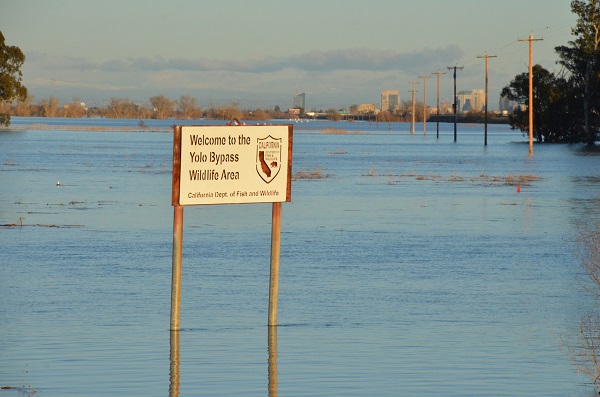Nor Cal hatchery workers save millions of trout and salmon

by CDFW
2-2-2017
Website
Following recent heavy rains, workers at the Nimbus and American River hatcheries labored around the clock to prevent massive debris loads from clogging the main water supply for below Nimbus Dam. Their intense efforts to clean intake structures and adjust water flows during battering winds and rains saved millions of eggs and young fish over the 11-day ordeal.
After a winter deluge from Jan. 7-18, the two hatcheries’ main water source experienced clogging that affected the water distribution system, putting more than 5.5 million trout and salmon eggs and 3 million young trout, steelhead and salmon in peril.
Both hatcheries are on a gravity water flow supply from the main intake screen at Nimbus Dam. There are no other filters until the water reaches each hatchery.
January storms swelled water levels at Folsom and Nimbus dams to the highest points since the El Niño floods of 1997-1998. The high flows resulted in a release of up to 60,000 cubic feet of water per second (cfs) from Nimbus Dam, while the normal rate is around 6,000-10,000 cfs. This huge water flow swept up debris that had collected above water line during the extensive drought. The debris clogged, overwhelmed and then incapacitated the automatic cleaning screen at the intake, compromising water flow to both hatcheries.
In a joint cooperative effort and at the height of the crisis, technicians from the Bureau of Reclamation devised a simple but effective way to quickly remove the debris clogging the main intake screen. They also bypassed systems that limited the time between cleaning cycles on the machinery, thereby allowing CDFW personnel to monitor the process 24 hours a day and keep water flowing to the hatcheries.
“It was a tense situation that called on our staff to work double shifts cleaning and operating the main intake structure screen and unclogging egg incubation jars inside each hatchery,” said Nimbus Hatchery Manager Paula Hoover. “They were working as fast as they could, 24/7, to save the fish.”
At American River Hatchery, the recent crisis threatened 1.4 million trout eggs in various stages of development, along with 1.7 million young trout. The fish and eggs were in danger of suffocation as the debris clog caused reduced oxygen levels and reduced the flow of water as much as 50 percent. Further complicating operations, the drum filter for the hatchery building was overwhelmed by the increased sediment, prompting workers to create a bypass to keep water flowing to the building.
The hatchery raises more than 2.5 million trout annually for planting in lakes, rivers and streams in 15 counties throughout northern and central California. More than a quarter of a million anglers utilize these waters for recreational fishing.
None of the Golden Trout rescued from the Volcanic Wilderness Area due to drought conditions were affected because they are housed in aquaculture systems that can be switched to 100 percent recirculation as needed. These Golden Trout will be kept at the hatchery until conditions in their natural habitat improve and they can be released back to the wild, likely in the late spring or early summer of this year.
At Nimbus Hatchery, 450,000 steelhead and 4.5 million salmon in various stages of development faced the same dire situation. Preparing for the worst, staff had emergency equipment ready to perform on-site releases of more than 250,000 year-old steelhead into the raging American River if conditions at the hatchery deteriorated further.
“The recreational and economic impact from potential loss of trout, salmon and steelhead from these two hatcheries would be substantial,” said North Central Region Fisheries Program Manager Kevin Thomas. “As usual, dedicated CDFW hatchery staff demonstrated exceptional care and effort, helping millions of fish survive to provide recreational, commercial and tribal fishing opportunities for California and the businesses they support.”
Photos
More Reports
California Department of Fish & Wildlife Reports
for Thursday, February 2nd, 2017
• Volunteers Needed for Bighorn Sheep Survey
• Flooding limits use of wild lands

1-31-2017
Youth hunters have a special opportunity coming up the weekend of Feb. 4-5. Youth Waterfowl Days will provide young licensed...... Read More

